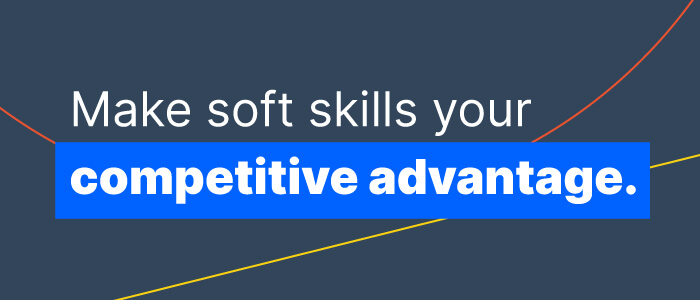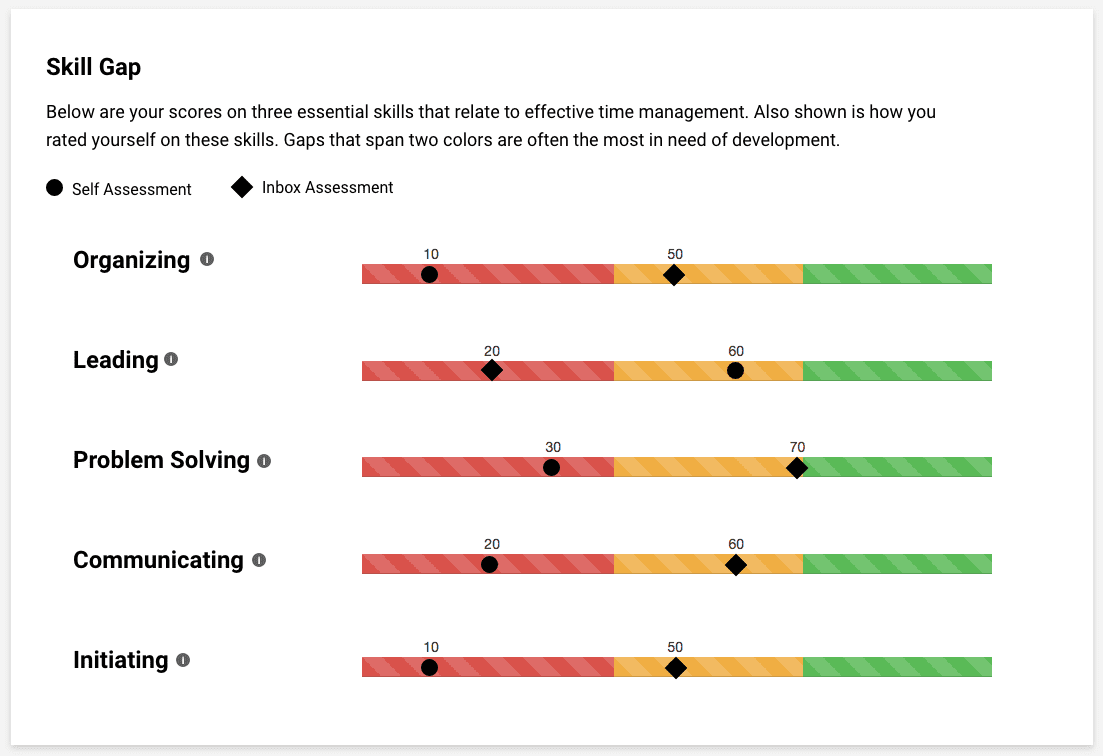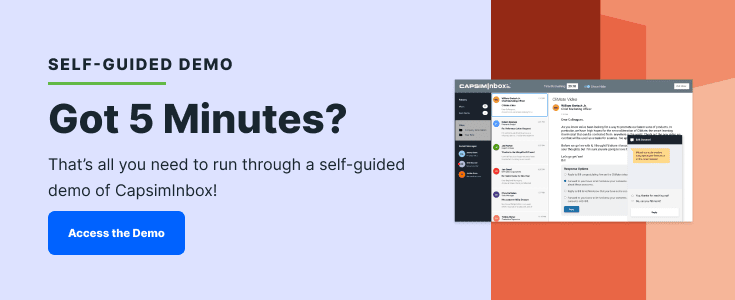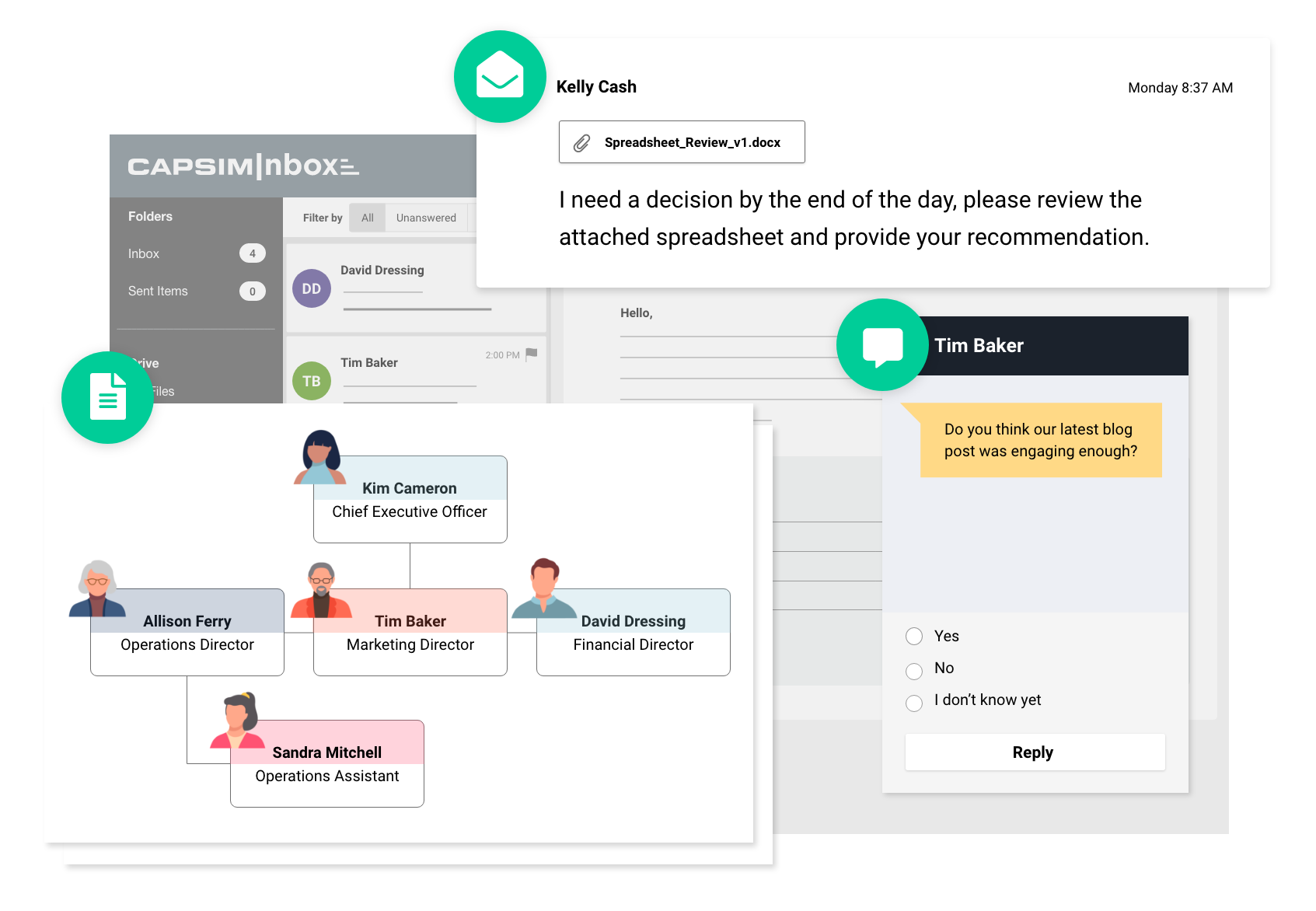How to Develop Soft Skills in the Workplace to Beat Out the Competition
August 4, 2021

Let’s assume there is parity in the technical skills of your competitors’ teams and yours. How are you going to differentiate and win using your people?
The answer: soft skills training. Here’s why.
If you go to two doctors of equal skill, and one is warm, welcoming, and answers every question while the other is cold and rushes you out the door as quickly as possible, who are you going to go back to? The doctor who made you feel valued.
The same principle is true in business. Nearly every market has multiple companies competing for the same customers with mostly similar products. Winning companies will excel at delivering a customer experience that makes customers want to work with them and even refer them to their colleagues and friends.
Assessing, hiring, and training for soft skills in the workplace influences how your team approaches their work and can give you an edge in beating out your competition.
But when it comes to analyzing and training for soft skills in your company, where do you start?
We’re going to talk through the process we’d use if we were taking over learning and development at a new company tomorrow. We’ll cover all aspects of soft skills in the workplace: why it’s important, the benefits, the step-by-step process, and the tools you need to make it happen.
The Importance of Soft Skills in the Workplace
Before we dig into the “how” of soft skills training, let’s look at why it can be such a powerful force within your company.
There’s been no shortage of research into the importance of soft skills and how they can positively impact companies of any size in any industry.
LinkedIn’s 2019 Global Talent Trends survey of over 5,100 hiring and talent professionals in 35 countries yielded the following insights:
- Ninety-two percent said soft skills matter as much or more than hard skills, and 80% said soft skills are increasingly important to organizational success.
- However, only 41% said they have a formal process for measuring soft skills.
- When it comes to bad hires, 89% said they typically lack soft skills.
But that’s not all.
- An IBM study found that CEOs ranked investment in people as the #1 way to accelerate performance.
- LinkedIn’s 2018 Workplace Learning Trends survey of talent developers, people managers, and executives identified training for soft skills as the #1 priority.
- The World Economic Forum’s 2016 “Future of Jobs” report suggested that soft skills like complex problem-solving, critical thinking, creativity, people management, and emotional intelligence would be a few of the most essential and critical skills in the workplace.
It seems everyone knows soft skills are incredibly important. But what skills and traits fall under the “soft skills” umbrella?
Examples of Soft Skills in the Workplace
Soft skills are defined as personal attributes, traits, and skills that influence the quality of your interactions with others. They help you build relationships, develop trust and reliability, and lead groups of people.
The personal attributes most commonly held up as examples of soft skills are:
- Attitude in the face of challenges, new situations, and around different types of people
- Promptness in showing up for work, meetings, and getting work done.
- Preparation for presentations, meetings, and in day-to-day work life.
- Communication skills when listening, speaking, or presenting.
- Problem-solving when circumstances change or within certain limitations.
- Decision-making for both short-term and long-term situations.
- Conflict resolution between others or with yourself and a coworker or client.
- Work ethic in getting tasks done, doing the small things, and being effective and efficient.
- Leadership for your team and across your organization.
- Empathy for others, their situations, and what’s going on in their lives.
- Time management to ensure work is getting done on time and to a high degree of quality.
- Critical thinking to find innovative solutions amidst company or market changes
- Working well in a team to help everyone feel welcomed, valued, and get to a great result.
- Networking within your company and your industry.
All of the above are crucial traits to identify and assess in hiring and continuous development initiatives. However, according to LinkedIn’s 2019 Global Talent Trends, there are five soft skills companies need but have a hard time finding:
- Creativity
- Persuasion
- Collaboration
- Adaptability
- Time management
Benefits of Developing Soft Skills Across Your Organization
What makes the above soft skills so vital to your company’s success? There are a few core reasons:
- Automation and artificial intelligence are replacing many human-driven processes, meaning the jobs of tomorrow place a lower emphasis on hard skills and more emphasis on interpersonal, relationship-building skills.
- Soft skills are always relevant and necessary, while hard skills come and go. For example, certain programming languages and frameworks may come and go, but programmers will always need to collaborate and solve complex problems.
- Skill learning platforms like Lynda, Udemy, and even YouTube have democratized learning hard and technical skills. If the playing field between you and competitors is level on technical skills, the biggest opportunity for differentiation is through leveling up and investing in your people with soft skills training.
We’ve seen the benefits of assessing and training for soft skills in the workplace ourselves.
We've also seen clients streamline their hiring processes. They spent countless hours and resources on hiring and replacing bad hires, but have since elevated their skills assessment processes and have had to replace fewer bad fits.
Others have used soft skills training with their support teams to bolster positive interactions with customers and enhance the customer experience. Additionally, some of our clients have created “feeder programs” to identify high-potential employees to further invest in.
Developing soft skills in your workplace pays off internally to help build a culture of continuous improvement and excellence, and externally in interactions with customers and prospects.
So, how do you take advantage of the benefits of soft skills?
How to Build a Competitive Advantage with Soft Skills Training
The following is how we’d build up a system for soft skills assessments, hiring, and ongoing training if we were starting at a new company tomorrow.
We’ll talk through each area of the company we’d implement soft skills assessments and development in, why it’s important, and how we would do it.
Assess Employee Soft Skill Gaps and Self-Awareness
The first place we’d start is assessing current employees. Why? To improve, we need to understand the skill gaps across the entire company, within specific teams, and down to the individual employee. Once we have a baseline, we can tailor ongoing training to close the skill gaps.
It’s also crucial that your soft skills assessments include a way to measure your employees’ self-awareness of their skills.
For example, Sheila in IT may think she’s good at managing her time. Or Dave in accounting may rate himself as a great collaborator. But if they aren’t skilled in those areas, then there is a disconnect between how they perceive themselves and how they actually interact with other employees and customers.
Self-awareness of skill gaps is crucial at this stage. Identifying these deficits now will help Sheila, Dave, and your other team members understand the need for improvement and buy into an ongoing learning and development program.
Finally, it’s essential that all employees go through these assessments. Creating a culture of infinite learning and development requires all employees, even the C-suite and executives, to actively participate. After all, wouldn’t you want every employee from the CEO on down to try to become the best version of themselves?
Now, let’s talk about the “how” behind assessing soft skills in your workplace.
As we know, soft skills are notorious for being hard to assess. But that’s only because traditional soft skill assessment methods themselves are ineffective, subjective, and open to bias.
LinkedIn found that hiring and talent managers mostly rely on these ineffective assessment methods to measure soft skills:
- Behavioral questions
- Reading body language
- Situational questions
However, remember that LinkedIn also found that 89% of bad hires lacked soft skills. So these methods for measuring soft skills don’t measure up. Body language can be coached and rehearsed, as can answers to behavioral and situational questions.
Tech-based assessment tools help remove bias and subjectivity. For example, CapsimInbox uses interactive and situation-based simulations in an inbox format. These simulations can be used to get a baseline of your team’s soft skills and identify skill gaps overall or in specific teams.
Soft Skill Assessments During the Hiring Process
No HR leader or hiring manager wants to continually have to try and fill positions because of previous bad hires. Yet we’ve already determined that the traditional methods to screen for soft skills are inadequate, and bad hires often lack soft skills.
You want to find the right cultural fits for your organization. Yes, potential hires need certain hard skills. But you also need to identify those candidates who will fit your culture, could positively impact your organization, and have the highest potential to become A+ contributors.
Only looking at resumes and reviewing cover letters introduces waste into your hiring process. You end up wasting time in interviews with non-fit candidates. So how can you ensure that when you decide to engage a candidate in an interview that it’s not a waste of time?
You need to assess the soft skills of the applicants who you are thinking of interviewing. With CapsimInbox, you can create short, engaging inbox simulations customized to the attributes required for specific positions. You then send your applicants the link to the simulation, have them complete it, and review the results.
You can streamline your hiring process by learning that an applicant you wanted to interview may look good on paper but may lack the soft skills needed for the open role.
You can also confirm a shortlist of candidates to interview, reduce total interview time, and offer the job to the applicant who has the highest potential of being a great fit for your team.
Create Individual Learning Plans
So we have our soft skills baseline for all current employees and new hires who come into our company. Now it’s time to address ongoing training and development.
Any ongoing soft skills development opportunities need to meet a few criteria:
- Tailored to the individual employee. Nothing is more uninteresting than training that is too general or doesn’t actually help your employees improve. But since we have our baseline soft skills assessment, we know exactly the type of skills to train and can tweak our content accordingly.
- Combines knowledge retention and practical application. It’s one thing to be told how to manage your time better. It’s another to be put in a real-life situation that forces you to do so. Applying conceptual knowledge is key to making meaningful progress in soft skill development.
- Provides immediate, actionable feedback. Your employees need more than right-wrong, pass-fail quizzes and tests. They need tips and insights that actually help them get better, not just test their knowledge retention abilities.
Inbox simulations check all of these boxes. Whether you use off-the-shelf simulations on a specific topic or build your own microsimulation, you can ensure your training content and desired outcomes align with what each employee needs to improve.
When your employees understand their training is aimed at helping them improve and close a specific skill gap, they stay engaged. Plus, the real-world scenarios simulations provide in short 30-minute-or-less bursts make it seem less like training and more like a game that can be done throughout the workday.
And because the simulations focus on a “day in the life” of a particular role, feedback is based on their actions and answers within the simulation. This is more lifelike, keeping your employees engaged and learning.
Each action and answer is recorded, providing data points for measuring progress. As the saying goes, “What gets measured gets improved.” Having the self-awareness of how they rate their proficiency combined with the actual data from the simulations can help your employees get better and improve over time.

Identify and Develop Future Leaders within Your Company
To this point, we’ve identified the soft skills gaps in our workplace with current employees. We’ve also created ways to assess potential hires to ensure we’re hiring those who have the highest potential of becoming great cultural fits and A+ players in our organization. Finally, we’ve developed individualized programs for our employees to continue to improve their soft skills.
But there’s one other way you can use soft skills in the workplace to benefit your company: identifying and developing future leaders.
Most companies make a massive mistake when it comes to looking for leaders within their company. They ask, “Who would be the best person to lead our design team?” and generally try to answer their question by looking at who the best designer is.
The problem is that they’re only looking at that person’s technical skills. However, just because an employee is a great designer, accountant, or engineer doesn’t necessarily mean they’ll be a good leader.
Using a soft skills training and tracking platform like CapsimInbox identifies and develops employees with higher potential for becoming a leader in our company. You increase your chances of making smarter development and promotion decisions that positively impact your company.
Assessing & Training Soft Skills in the Workplace with Simulations
From assessing soft skills in potential hires and current employees to building an ongoing learning plan, simulations offer numerous benefits other training methods don’t.
- Engaging - simulations immerse learners in real-life scenarios relevant to their role and their work. Compared to multi-hour classroom sessions with Powerpoints, simulations keep employees engaged with short, game-like training modules.
- Learning by doing - reciting concepts and vocabulary doesn’t help your employees improve. Putting theory into practice in day-in-the-life simulations engrains concepts through practical, relevant experiences.
- Self-awareness - simulations use baseline measurements and progressive data points to show employees the difference between their perception of their skills and where they actually stand.
- Valuable feedback - pass-fail and right-wrong quizzes only test knowledge retention. With knowledge application in simulations comes direct and immediate feedback that your employees can implement right away.
Build Your Competitive Advantage with CapsimInbox
Assessing and training for soft skills in the workplace can touch every part of your organization. The modern workplace is interpersonal and requires your employees to work well together and have the aptitude to interact with customers, potential customers, vendors, and the general public successfully.
At the same time, technical skills are less of a differentiator in this modern workplace. Investing in your people to create a competitive advantage means looking beyond technical skills to help them become high-impact team members.
Regardless of the size of your company or the industry you’re in, CapsimInbox is a flexible, scalable, and cost-efficient option for developing soft skills in the workplace. Creating new simulations is as easy as writing emails.
Our CapsimInbox self-guided demo gives you a hands-on look at our inbox simulations.





.png?width=80&name=1-questions%20(1).png)